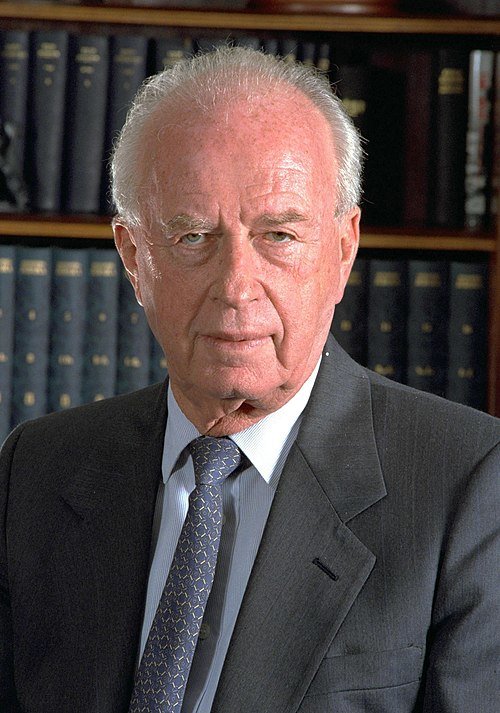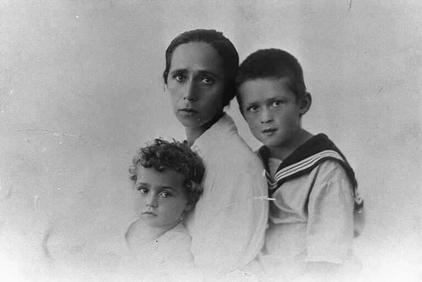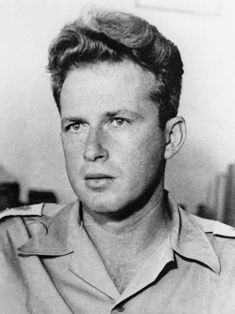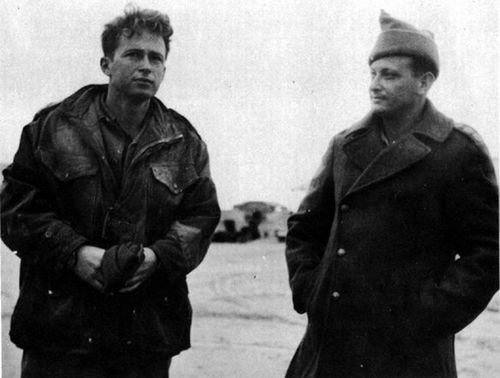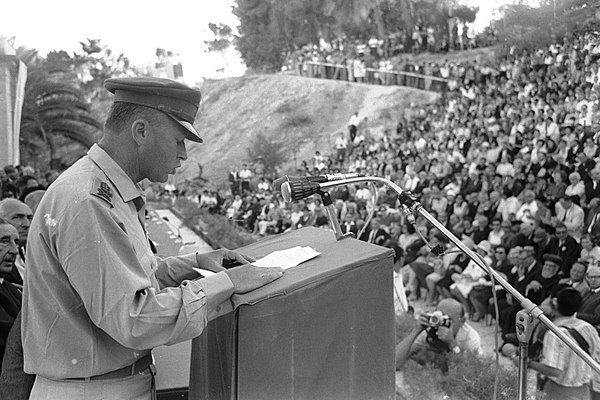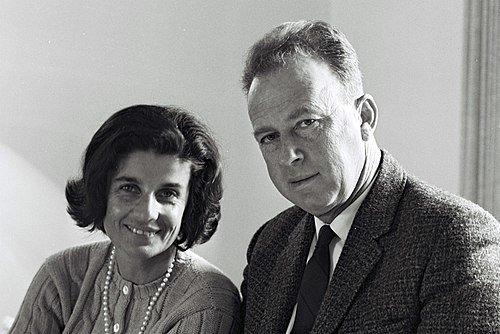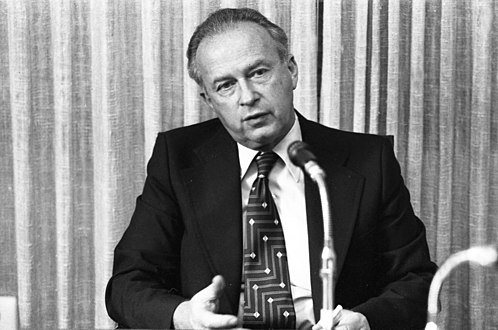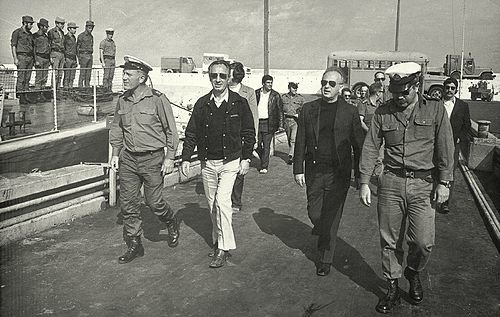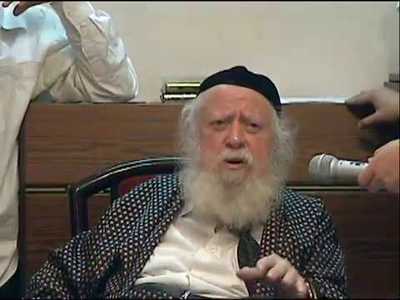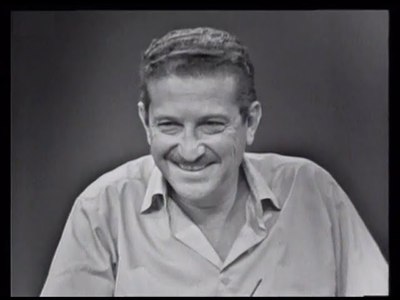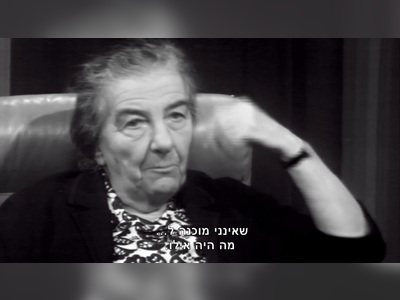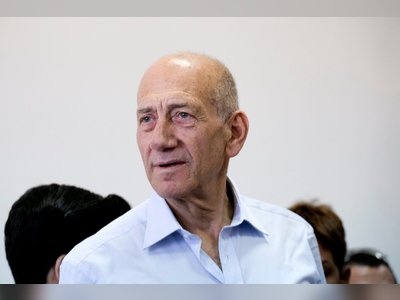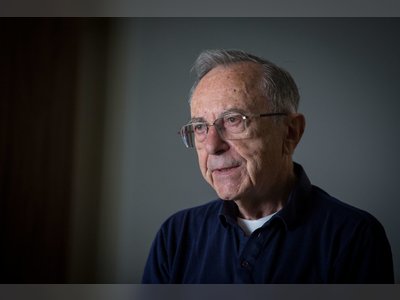מורשת גדולי האומה
בזכותם קיים
beta
Isaac Rabin
Isaac Rabin (1st of Adar, 5722, March 1, 1922 – 12th of Cheshvan, 5756, November 4, 1995) was the fifth Prime Minister of Israel and the seventh Chief of Staff of the Israel Defense Forces (IDF).
Rabin began his military career as a commander in the Palmach, a Jewish underground militia, and later served as the commander of the Harel Brigade during the War of Independence. He went on to become the seventh Chief of Staff of the IDF during the Six-Day War. After his retirement from the IDF, he served as Israel's ambassador to the United States and later as the Prime Minister of Israel, representing the Labor Party, in two separate terms: first from 1974 to 1977, during which he ordered Operation Entebbe, and secondly from 1992 to 1995 when he signed the Oslo Accords and the peace agreement with Jordan. Additionally, he held the position of Defense Minister for approximately nine years during his political career.
Rabin was the first Prime Minister of Israel to have been born in the country.
For his role in the Oslo Accords, he was awarded the Nobel Peace Prize in 1994, alongside Shimon Peres and Yasser Arafat. Tragically, Rabin was assassinated while serving as Prime Minister by a Jewish-Israeli extremist, Yigal Amir, who opposed the Oslo Accords.
Isaac Rabin was born in Jerusalem during the British Mandate period. His parents, Rosa Cohen and Nehemia Rabin, were part of the Third Aliyah, the third wave of Jewish immigration to Palestine, and members of the Mapai Party.
Rabin's mother, Rosa, born in 1890 in Mohilev, Belarus (then part of the Russian Empire), was known as "Rosa the Red" due to her political activism. Her father, Isaac, was a rabbi and a Chabad Hasid who opposed Zionism. Despite her father's opposition, Rosa sought a general education and attended a girls' high school in Homel, where she became involved in revolutionary and political activities. In 1919, she immigrated to Palestine secretly on the ship "Russlan," considered one of the pioneers of the Third Aliyah. She initially settled in Kibbutz Kinneret and later moved to Jerusalem, where she met Nehemia Rabin. The two were married in 1921, and Isaac Rabin was named after his grandfather, Isaac Cohen. Through his mother's side, Rabin had family connections to David Cohen, his mother's cousin, and from there to the Rofin, Suknik (Yadin), Yedlin, and other families.
Rabin's father, Nehemia Rabinovitz, was born in 1886 in Semydubychi, Ukraine. He lost his father at a young age and helped support the family. At the age of eighteen, Nehemia emigrated to the United States, where he joined the Poale Zion movement. There, he also changed his family name to Rabin. In 1917, he joined the Jewish Legion, which was established in the United States by Ze'ev Jabotinsky and David Ben-Gurion, and sailed with the legion to Palestine.
When Rabin was one year old, his family moved to live in Haifa, where his sister Rachel was born in 1925. Due to his father's work at the Electric Company, the family relocated to the Shabazi neighborhood in Tel Aviv. There, his mother began working for the Histadrut's permanent staff, and later, she was elected to the Tel Aviv City Council. In later interviews, Rabin described the atmosphere at home as "semi-military," as his mother was often absent.
In 1928, Rabin started his education at the "Elementary School for Workers' Children A" on Tchernichovsky Street in Tel Aviv. This experimental school, established in 1924 in Tel Aviv, aimed to combine socialism and Hebrew education. At a young age, Rabin showed an interest in progressive and revolutionary circles and was socially and politically active. In 1919, he immigrated to Eretz Israel secretly aboard the ship "Russlan," considered a pioneer of the Third Aliyah. Initially, she settled in Kibbutz Kinneret and later moved to Jerusalem, where she met Nehemia Rabin. The two were married in 1921, and Isaac Rabin was named after his grandfather, Isaac Cohen. Through his mother's side, Rabin had family connections to David Cohen, his mother's cousin, and from there to the Rofin, Suknik (Yadin), Yedlin, and other families.
Rabin's father, Nehemia Rabinovitz, was born in 1886 in Semydubychi, Ukraine. He lost his father at a young age and helped support the family. At the age of eighteen, Nehemia emigrated to the United States, where he joined the Poale Zion movement. There, he also changed his family name to Rabin. In 1917, he joined the Jewish Legion, which was established in the United States by Ze'ev Jabotinsky and David Ben-Gurion, and sailed with the legion to Palestine.
When Rabin was one year old, his family moved to live in Haifa, where his sister Rachel was born in 1925. Due to his father's work at the Electric Company, the family relocated to the Shabazi neighborhood in Tel Aviv. There, his mother began working for the Histadrut's permanent staff, and later, she was elected to the Tel Aviv City Council. In later interviews, Rabin described the atmosphere at home as "semi-military," as his mother was often absent.
In 1928, Rabin started his education at the "Elementary School for Workers' Children A" on Tchernichovsky Street in Tel Aviv. This experimental school, established in 1924 in Tel Aviv, aimed to combine socialism and Hebrew education. At a young age, Rabin showed an interest in progressive and revolutionary circles and was socially and politically active. In 1919, she immigrated to Eretz Israel secretly aboard the ship "Russlan," considered a pioneer of the Third Aliyah. Initially, she settled in Kibbutz Kinneret and later moved to Jerusalem, where she met Nehemia Rabin. The two were married in 1921, and Isaac Rabin was named after his grandfather, Isaac Cohen. Through his mother's side, Rabin had family connections to David Cohen, his mother's cousin, and from there to the Rofin, Suknik (Yadin), Yedlin, and other families.
Rabin's father, Nehemia Rabinovitz, was born in 1886 in Semydubychi, Ukraine. He lost his father at a young age and helped support the family. At the age of eighteen, Nehemia emigrated to the United States, where he joined the Poale Zion movement. There, he also changed his family name to Rabin. In 1917, he joined the Jewish Legion, which was established in the United States by Ze'ev Jabotinsky and David Ben-Gurion, and sailed with the legion to Palestine.
When Rabin was one year old, his family moved to live in Haifa, where his sister Rachel was born in 1925. Due to his father's work at the Electric Company, the family relocated to the Shabazi neighborhood in Tel Aviv. There, his mother began working for the Histadrut's permanent staff, and later, she was elected to the Tel Aviv City Council. In later interviews, Rabin described the atmosphere at home as "semi-military," as his mother was often absent.
In 1928, Rabin started his education at the "Elementary School for Workers' Children A" on Tchernichovsky Street in Tel Aviv. This experimental school, established in 1924 in Tel Aviv, aimed to combine socialism and Hebrew education. At a young age, Rabin showed an interest in progressive and revolutionary circles and was socially and politically active. In 1919, she immigrated to Eretz Israel secretly aboard the ship "Russlan," considered a pioneer of the Third Aliyah. Initially, she settled in Kibbutz Kinneret and later moved to Jerusalem, where she met Nehemia Rabin. The two were married in 1921, and Isaac Rabin was named after his grandfather, Isaac Cohen. Through his mother's side, Rabin had family connections to David Cohen, his mother's cousin, and from there to the Rofin, Suknik (Yadin), Yedlin, and other families.
Rabin's father, Nehemia Rabinovitz, was born in 1886 in Semydubychi, Ukraine. He lost his father at a young age and helped support the family. At the age of eighteen, Nehemia emigrated to the United States, where he joined the Poale Zion movement. There, he also changed his family name to Rabin. In 1917, he joined the Jewish Legion, which was established in the United States by Ze'ev Jabotinsky and David Ben-Gurion, and sailed with the legion to Palestine.
When Rabin was one year old, his family moved to live in Haifa, where his sister Rachel was born in 1925. Due to his father's work at the Electric Company, the family relocated to the Shabazi neighborhood in Tel Aviv. There, his mother began working for the Histadrut's permanent staff, and later, she was elected to the Tel Aviv City Council. In later interviews, Rabin described the atmosphere at home as "semi-military," as his mother was often absent.
In 1928, Rabin started his education at the "Elementary School for Workers' Children A" on Tchernichovsky Street in Tel Aviv. This experimental school, established in 1924 in Tel Aviv, aimed to combine socialism and Hebrew education. At a young age, Rabin showed an interest in progressive and revolutionary circles and was socially and politically active. In 1919, she immigrated to Eretz Israel secretly aboard the ship "Russlan," considered a pioneer of the Third Aliyah. Initially, she settled in Kibbutz Kinneret and later moved to Jerusalem, where she met Nehemia Rabin. The two were married in 1921, and Isaac Rabin was named after his grandfather, Isaac Cohen. Through his mother's side, Rabin had family connections to David Cohen, his mother's cousin, and from there to the Rofin, Suknik (Yadin), Yedlin, and other families.
Rabin's father, Nehemia Rabinovitz, was born in 1886 in Semydubychi, Ukraine. He lost his father at a young age and helped support the family. At the age of eighteen, Nehemia emigrated to the United States, where he joined the Poale Zion movement. There, he also changed his family name to Rabin. In 1917, he joined the Jewish Legion, which was established in the United States by Ze'ev Jabotinsky and David Ben-Gurion, and sailed with the legion to Palestine.
When Rabin was one year old, his family moved to live in Haifa, where his sister Rachel was born in 1925. Due to his father's work at the Electric Company, the family relocated to the Shabazi neighborhood in Tel Aviv. There, his mother began working for the Histadrut's permanent staff, and later, she was elected to the Tel Aviv City Council. In later interviews, Rabin described the atmosphere at home as "semi-military," as his mother was often absent.
In 1928, Rabin started his education at the "Elementary School for Workers' Children A" on Tchernichovsky Street in Tel Aviv. This experimental school, established in 1924 in Tel Aviv, aimed to combine socialism and Hebrew education. At a young age, Rabin showed an interest in progressive and revolutionary circles and was socially and politically active.
Rabin was the first Prime Minister of Israel to have been born in the country.
For his role in the Oslo Accords, he was awarded the Nobel Peace Prize in 1994, alongside Shimon Peres and Yasser Arafat. Tragically, Rabin was assassinated while serving as Prime Minister by a Jewish-Israeli extremist, Yigal Amir, who opposed the Oslo Accords.
Early Life
Isaac Rabin was born in Jerusalem during the British Mandate period. His parents, Rosa Cohen and Nehemia Rabin, were part of the Third Aliyah, the third wave of Jewish immigration to Palestine, and members of the Mapai Party.
Rabin's mother, Rosa, born in 1890 in Mohilev, Belarus (then part of the Russian Empire), was known as "Rosa the Red" due to her political activism. Her father, Isaac, was a rabbi and a Chabad Hasid who opposed Zionism. Despite her father's opposition, Rosa sought a general education and attended a girls' high school in Homel, where she became involved in revolutionary and political activities. In 1919, she immigrated to Palestine secretly on the ship "Russlan," considered one of the pioneers of the Third Aliyah. She initially settled in Kibbutz Kinneret and later moved to Jerusalem, where she met Nehemia Rabin. The two were married in 1921, and Isaac Rabin was named after his grandfather, Isaac Cohen. Through his mother's side, Rabin had family connections to David Cohen, his mother's cousin, and from there to the Rofin, Suknik (Yadin), Yedlin, and other families.
Rabin's father, Nehemia Rabinovitz, was born in 1886 in Semydubychi, Ukraine. He lost his father at a young age and helped support the family. At the age of eighteen, Nehemia emigrated to the United States, where he joined the Poale Zion movement. There, he also changed his family name to Rabin. In 1917, he joined the Jewish Legion, which was established in the United States by Ze'ev Jabotinsky and David Ben-Gurion, and sailed with the legion to Palestine.
When Rabin was one year old, his family moved to live in Haifa, where his sister Rachel was born in 1925. Due to his father's work at the Electric Company, the family relocated to the Shabazi neighborhood in Tel Aviv. There, his mother began working for the Histadrut's permanent staff, and later, she was elected to the Tel Aviv City Council. In later interviews, Rabin described the atmosphere at home as "semi-military," as his mother was often absent.
In 1928, Rabin started his education at the "Elementary School for Workers' Children A" on Tchernichovsky Street in Tel Aviv. This experimental school, established in 1924 in Tel Aviv, aimed to combine socialism and Hebrew education. At a young age, Rabin showed an interest in progressive and revolutionary circles and was socially and politically active. In 1919, he immigrated to Eretz Israel secretly aboard the ship "Russlan," considered a pioneer of the Third Aliyah. Initially, she settled in Kibbutz Kinneret and later moved to Jerusalem, where she met Nehemia Rabin. The two were married in 1921, and Isaac Rabin was named after his grandfather, Isaac Cohen. Through his mother's side, Rabin had family connections to David Cohen, his mother's cousin, and from there to the Rofin, Suknik (Yadin), Yedlin, and other families.
Rabin's father, Nehemia Rabinovitz, was born in 1886 in Semydubychi, Ukraine. He lost his father at a young age and helped support the family. At the age of eighteen, Nehemia emigrated to the United States, where he joined the Poale Zion movement. There, he also changed his family name to Rabin. In 1917, he joined the Jewish Legion, which was established in the United States by Ze'ev Jabotinsky and David Ben-Gurion, and sailed with the legion to Palestine.
When Rabin was one year old, his family moved to live in Haifa, where his sister Rachel was born in 1925. Due to his father's work at the Electric Company, the family relocated to the Shabazi neighborhood in Tel Aviv. There, his mother began working for the Histadrut's permanent staff, and later, she was elected to the Tel Aviv City Council. In later interviews, Rabin described the atmosphere at home as "semi-military," as his mother was often absent.
In 1928, Rabin started his education at the "Elementary School for Workers' Children A" on Tchernichovsky Street in Tel Aviv. This experimental school, established in 1924 in Tel Aviv, aimed to combine socialism and Hebrew education. At a young age, Rabin showed an interest in progressive and revolutionary circles and was socially and politically active. In 1919, she immigrated to Eretz Israel secretly aboard the ship "Russlan," considered a pioneer of the Third Aliyah. Initially, she settled in Kibbutz Kinneret and later moved to Jerusalem, where she met Nehemia Rabin. The two were married in 1921, and Isaac Rabin was named after his grandfather, Isaac Cohen. Through his mother's side, Rabin had family connections to David Cohen, his mother's cousin, and from there to the Rofin, Suknik (Yadin), Yedlin, and other families.
Rabin's father, Nehemia Rabinovitz, was born in 1886 in Semydubychi, Ukraine. He lost his father at a young age and helped support the family. At the age of eighteen, Nehemia emigrated to the United States, where he joined the Poale Zion movement. There, he also changed his family name to Rabin. In 1917, he joined the Jewish Legion, which was established in the United States by Ze'ev Jabotinsky and David Ben-Gurion, and sailed with the legion to Palestine.
When Rabin was one year old, his family moved to live in Haifa, where his sister Rachel was born in 1925. Due to his father's work at the Electric Company, the family relocated to the Shabazi neighborhood in Tel Aviv. There, his mother began working for the Histadrut's permanent staff, and later, she was elected to the Tel Aviv City Council. In later interviews, Rabin described the atmosphere at home as "semi-military," as his mother was often absent.
In 1928, Rabin started his education at the "Elementary School for Workers' Children A" on Tchernichovsky Street in Tel Aviv. This experimental school, established in 1924 in Tel Aviv, aimed to combine socialism and Hebrew education. At a young age, Rabin showed an interest in progressive and revolutionary circles and was socially and politically active. In 1919, she immigrated to Eretz Israel secretly aboard the ship "Russlan," considered a pioneer of the Third Aliyah. Initially, she settled in Kibbutz Kinneret and later moved to Jerusalem, where she met Nehemia Rabin. The two were married in 1921, and Isaac Rabin was named after his grandfather, Isaac Cohen. Through his mother's side, Rabin had family connections to David Cohen, his mother's cousin, and from there to the Rofin, Suknik (Yadin), Yedlin, and other families.
Rabin's father, Nehemia Rabinovitz, was born in 1886 in Semydubychi, Ukraine. He lost his father at a young age and helped support the family. At the age of eighteen, Nehemia emigrated to the United States, where he joined the Poale Zion movement. There, he also changed his family name to Rabin. In 1917, he joined the Jewish Legion, which was established in the United States by Ze'ev Jabotinsky and David Ben-Gurion, and sailed with the legion to Palestine.
When Rabin was one year old, his family moved to live in Haifa, where his sister Rachel was born in 1925. Due to his father's work at the Electric Company, the family relocated to the Shabazi neighborhood in Tel Aviv. There, his mother began working for the Histadrut's permanent staff, and later, she was elected to the Tel Aviv City Council. In later interviews, Rabin described the atmosphere at home as "semi-military," as his mother was often absent.
In 1928, Rabin started his education at the "Elementary School for Workers' Children A" on Tchernichovsky Street in Tel Aviv. This experimental school, established in 1924 in Tel Aviv, aimed to combine socialism and Hebrew education. At a young age, Rabin showed an interest in progressive and revolutionary circles and was socially and politically active. In 1919, she immigrated to Eretz Israel secretly aboard the ship "Russlan," considered a pioneer of the Third Aliyah. Initially, she settled in Kibbutz Kinneret and later moved to Jerusalem, where she met Nehemia Rabin. The two were married in 1921, and Isaac Rabin was named after his grandfather, Isaac Cohen. Through his mother's side, Rabin had family connections to David Cohen, his mother's cousin, and from there to the Rofin, Suknik (Yadin), Yedlin, and other families.
Rabin's father, Nehemia Rabinovitz, was born in 1886 in Semydubychi, Ukraine. He lost his father at a young age and helped support the family. At the age of eighteen, Nehemia emigrated to the United States, where he joined the Poale Zion movement. There, he also changed his family name to Rabin. In 1917, he joined the Jewish Legion, which was established in the United States by Ze'ev Jabotinsky and David Ben-Gurion, and sailed with the legion to Palestine.
When Rabin was one year old, his family moved to live in Haifa, where his sister Rachel was born in 1925. Due to his father's work at the Electric Company, the family relocated to the Shabazi neighborhood in Tel Aviv. There, his mother began working for the Histadrut's permanent staff, and later, she was elected to the Tel Aviv City Council. In later interviews, Rabin described the atmosphere at home as "semi-military," as his mother was often absent.
In 1928, Rabin started his education at the "Elementary School for Workers' Children A" on Tchernichovsky Street in Tel Aviv. This experimental school, established in 1924 in Tel Aviv, aimed to combine socialism and Hebrew education. At a young age, Rabin showed an interest in progressive and revolutionary circles and was socially and politically active.
- יצחק רביןhe.wikipedia.org
